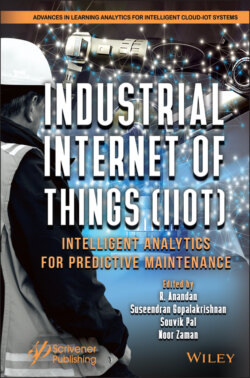Читать книгу Industrial Internet of Things (IIoT) - Группа авторов - Страница 19
1.3.2 Industrial Internet of Things
ОглавлениеThe world is experiencing a digital transformation and the IIoT aims to connect different devices to collect and transmit data in an industrial environment. Performing this communication through essential variables related to the devices, the communication between the devices, the data, and the data analysis. The concept is the same as the IoT used for home appliances; however, for IIoT, the connection is between industrial machines, legacy systems, and other devices related to the world of production. This can be applied in sectors such as facility management, supply chain monitoring, healthcare, and retail, among others [8].
The application of IIoT is through a network of devices and intelligent objects that collect, through sensors, and share large amounts of data. This forms a technological layer that can directly connect a product supplier in real time on the production line, which analyzes the quality and use of your product. This through intelligent data consumption creating a critical profile can connect the logistic chain of input and output of materials and control production, in real time, at the optimum point of operation [9].
The main challenges of IIoT are interoperability, security, and a high volume of data exchange. Interoperability is the ability of different systems and organizations to work together, considering the difficulty on the appearance of devices from different brands is a challenge and it is necessary to develop technological initiatives to unify these systems. Security is a challenge because companies need to know that their data is safe, and it is necessary to guarantee the necessary infrastructure for an exponential explosion of data [10].
Thus, IIoT comprises of machines connected to the internet and advanced analytics platforms (digital structure) that process the data produced, and IIoT devices range from complex industrial robots to tiny environmental sensors; however, the technology also includes agriculture, financial services, healthcare, retail, and advertising, among others. To get the most out of the benefits of IIoT, three technological capabilities related to sensor-oriented computing, industrial analytics, and the application of intelligent machines are needed [49].
IIoT technology can be applied in various sectors such as production where most of the technology is being implemented and employed, derived from machines that can autonomously monitor, analyze, and predict potential problems, meaning less downtime and more efficiency in general, or even simpler and safer facility management with sensor-driven climate controls. In addition, intelligent devices that monitor facility entry points and react quickly to potential threats improve facility security, or even supply chain with sensor-managed inventory taking care of supplies orders before stocks run out. This reduces waste, while keeping the necessary goods in stock and freeing workers to focus on other more specific tasks [49–51].
This large industrial data generation machine will be an opportunity to explore capacities related to sensor-driven computing, thus enabling the measurement of temperature, pressure, speed, and several other parameters. Given that all this information is valuable to innovate in services, it is usually data that customers do not have access to [51].
With regard to Industrial Analytics, the data generated through the sensors allows the industrial analysis to transform this data into valuable insights, managing to extract all the information from the thousands of data generated daily and then serving for decision-making and action plans, as alarms that constantly signal for abnormalities of processes. Still evaluating that the raw data are transformed into valuable insights into the conditions of the industrial plant, this will allow it to control the plant with greater precision, increasing productivity and decreasing losses [50, 51]; or even applying intelligent machines, i.e., machines that do not have only mechanical functions, considering that this will be the driving force for the generation of new revenue streams, reinforcing the concept of a hybrid business model; or even, the advancement of technology is making it possible to compose physical intelligent devices and their monitoring software with third-party services [52, 53].
With IIoT technology, the production process is differentiated, that is, there is greater communication between what is produced and the machine, aiming that any inconsistency can be detected during the production process, thus greater quality control. Inventory control is also more efficient with the use of IoT sensors, which can verify the need for parts replacement. Thus, in addition to accurate inventories, there is a streamlining of processes and savings, both for employee time in controlling inventory and to avoid wasting unnecessary purchases [52–54].
